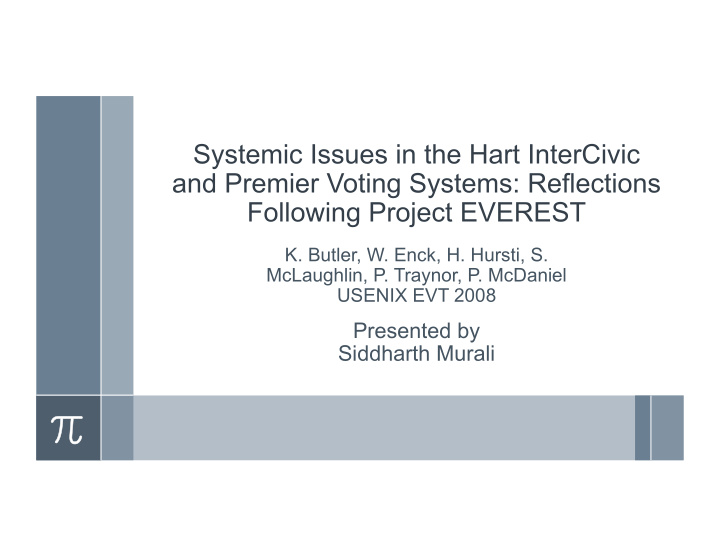



Systemic Issues in the Hart InterCivic and Premier Voting Systems: Reflections Following Project EVEREST K. Butler, W. Enck, H. Hursti, S. McLaughlin, P. Traynor, P. McDaniel USENIX EVT 2008 Presented by Siddharth Murali
Introduction › Ohio’s voting systems – Premier Elections Solutions – Hart InterCivic – Election Systems & Software › Project EVEREST – Teams from academia and industry to assess risks with Ohio’s current voting systems › Penn State Team – Focused on Hart InterCivic and Premier systems
Hart InterCivic System › Typical election procedure in Ohio – Master key generation – Election database creation – Data is written to storage cards called MBBs – One MBB is used per JBC/eScan – SERVO software is used to reset memory of eScans – SERVO is also used to transfer shared key from eCM to JBC/ eScan – Voters fill out paper ballots, enter them in the machine, which tallies the results – MBBs are retrieved and processed to create a election result database – Machines are backed up and firmware is verified
Hart – Election Data Integrity › Single Shared key is used for an entire county – Easy to retrieve for an attacker with physical access › MBB Images – Data can be removed by copying › Bypassing passwords – Passwords are kept in a config file that is easily read › Third-party vulnerabilities – Uses functionality from old Windows OS
Hart – Unsafe Functionality › Many testing features used in legitimate interfaces › eScan – Config file is available, can do things like allow duplicate ballots › JBC and eSlate – Can create fake button presses to vote any number of times › EMS – Can silently write the key to a debug file in plaintext › Ballot Now – Autovote menu allows attacker to generate and print pre-filled in ballots
Hart – Malicious Insiders › Polling Place – Poll workers can collude with voters or monitor them to influence votes › eScan – Replaced memory card containing the executable, and booted into Linux › JBC – Voter codes can be rapidly generated during early voting › Election Headquarters – Tally software can be fooled into discounting votes, UI is configurable through Windows registry
Hart - Auditing › Can alert an auditor about suspicious events or presence of malicious intent › EMS Audit Logs – Databse storing logs can be attacked and logs modified, easy if you know passwords › Compromising the VVPAT record – Attacker who controls the printer interface can print anything to it › Open Interfaces on voting equipment – JBC and eScan have interfaces that allow erasing of votes and audit logs via commands through an Ethernet cable
Premier Elections System › Election begins by defining ballot › GEMS server communicates over LAN with EMP, which encodes memory cards used at the polling places › EMP is a PC running Windows 2000 connected to an external drive bay › Election is opened by a precinct administrator who inserts a Supervisor card into the EMP › Voters receive a Voter card, insert it into the machine and vote › The voter then returns the voter card, and the supervisor closes the election by inserting his card › Memory cards are shipped to the election headquarters which communicate the results to GEMS server over LAN, which prints an official summary
Premier – Vote Integrity and Privacy › Casting an unlimited number of ballots – Multiple voter cards can be used after exploiting vulnerabilities in AV-TSX › Exposing Voter choices – Audit log timestamps can indicate when a voter entered, and can approximate the voter’s choice › Failure to address previous vulnerabilities – Large portions of EMP code was copied exactly from AV-TSX
Premier – Malicious Insiders › State of Ohio required that additional third party software like McAfee, Verdasys Digital Guardian be used to protect GEMS › Protecting GEMS with Digital Guardian – Enforces 2 policies – 3 users created with unique access privileges › Circumventing Digital Guardian – Misconfiguration of Windows – Limitations of approach for policy specification – Can modify bootloader config and disable Digital Guardian
Premier – Software Update Authentication › ExpressPoll – Attacker that can power cycle and insert new memory card can load and execute the file (like a bootloader) on the memory card – Source of files is never authenticated › VCE – No authentication of new software loaded – Can be used to create valid Voter Cards by just turning device off and pressing off button again to load new software › Digital Guardian – Adversary can replace a whitelisted application to gain its privileges
Premier – Trustworthy Auditing › ExpressPoll – Audit logs can be modified/deleted by anyone in possession of the device › Digital Guardian – Activity Logging is disabled by default › EMP – Logs can be modified outside the application, or deleted without alarm › AV-TSX VVPAT – Printer wires are easily exposed – Can easily insert chemicals to destroy information written to printer paper
Premier –Security Engineering Practices › Ineffective Application of Security Techniques – Same data key used throughout the county – Decryption key used in EMP derived from serial number – ExpressPoll provides no database protection › Systemic Trust Assumptions – Same data key used by EMP and all AV-TSX devices – EMP can perform all AV-TSX operations and validate the results – EMP always trusts user to enter correct data, user cannot change the value if entered wrong
Discussion › Contributions/Limitations of the paper? › Do you think that these attacks have influenced elections? › Have there been any changes in these machines in the past 8 years? › Similar projects in other states?
Recommend
More recommend